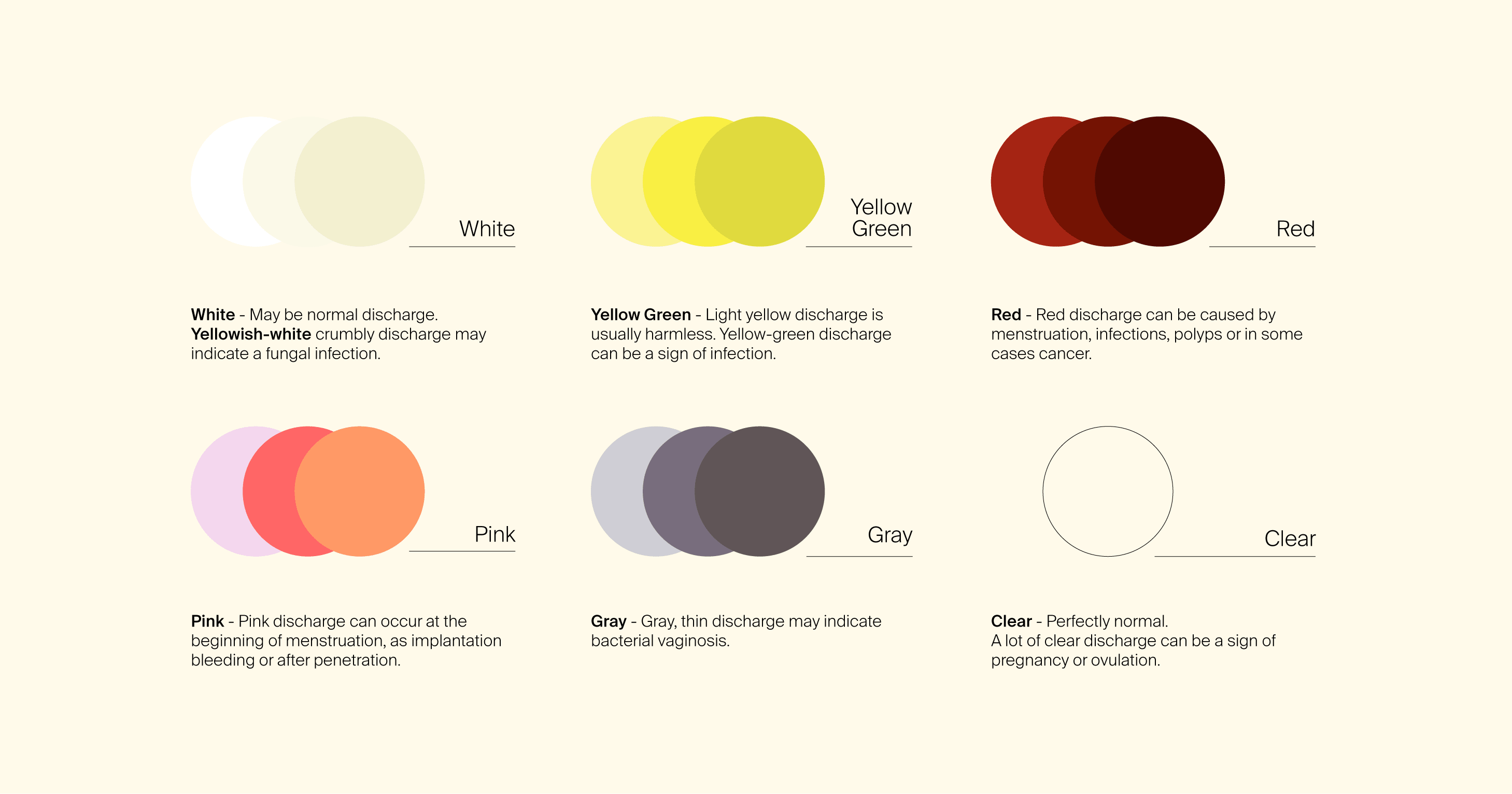In this article, find out if vaginal discharge before your period is normal, and what the color and consistency mean.
Key Facts about Vaginal Discharge:
- Vaginal discharge before your period is normal and is caused by hormonal changes.
- Clear discharge occurs more frequently around ovulation and is slippery, which facilitates the passage of sperm.
- Brownish discharge before your period is often old blood and harmless.
- Yellow or green discharge can indicate infections such as bacterial vaginosis or sexually transmitted diseases like gonorrhea or trichomoniasis.
- Consult your healthcare provider for any abnormal discharge (green, grey, unpleasant odor, itching, burning, significant changes), as these can be a sign of an infection.
Almost All Women Experience Vaginal Discharge Before Their Period
Many women experience a change in their vaginal discharge throughout their cycle, especially before their period. This discharge can have different colors, consistencies, and odors and is a natural part of the female menstrual cycle, directly related to women's health and the reproductive system.
In this article, we will take a closer look at what vaginal discharge before your period means, why it occurs, and when it is advisable to seek medical advice.

How Does Vaginal Discharge Change Before Your Period?
Hormonal fluctuations occur throughout the menstrual cycle, which also affect vaginal discharge. In the days leading up to your period, estrogen levels drop, and the body prepares for menstruation. Typical characteristics of this phase are:
- Consistency: The discharge usually becomes creamy to thick.
- Color: It can appear off-white or yellowish.
- Amount: The amount of discharge often decreases.
Vaginal discharge before your period, also known as premenstrual discharge, refers to the changes in vaginal discharge that may occur a few days before the start of menstruation.
What’s Normal And What’s Not?
Normal discharge has no strong odor and causes no discomfort. However, you should seek medical attention if you experience the following abnormalities or symptoms:
- Greenish or grey discharge.
- Unpleasant odor.
- Itching or burning when urinating (may indicate an infection, e.g., bacterial vaginosis, yeast infection, chlamydia).
- Redness of the inner and outer labia.
You can learn about when discharge is normal and how to recognize abnormal discharge in this video:
What Does Vaginal Discharge Before Your Period Mean?
Vaginal discharge before your period is caused by hormonal changes in the body. During a woman’s menstrual cycle, her body goes through various phases controlled by hormones like estrogen and progesterone. In the second half of the cycle, after ovulation, progesterone levels rise, which can lead to changes in vaginal discharge.
In addition to hormones, the vaginal environment also plays a role in the consistency of the discharge. A healthy vaginal environment is slightly acidic and dominated by lactic acid bacteria. These protect against infections. Factors such as stress, inappropriate intimate hygiene, or the use of antibiotics can disrupt this balance and increase the pH level. This can lead to altered discharge and an increased susceptibility to infections.
Below is a brief overview of what vaginal discharge before your period can mean, what is normal, and what you should have checked:

White Discharge
To maintain vaginal health and ensure proper lubrication, the vagina produces a natural discharge called leukorrhea. This fluid, which can be white or slightly yellow, consists of secretions and shed cells. It's a normal part of the body's function and occurs throughout the menstrual cycle.
The time after ovulation and before your period is called the luteal phase. During this time, the hormone progesterone predominates. Under the influence of progesterone, the discharge becomes milky white.
Sticky or creamy discharge makes it difficult for sperm to reach the cervix. This makes sense, as this type of discharge usually occurs when you are no longer fertile – between ovulation and the start of your period. Other reasons for white discharge can include:
- Hormonal birth control (e.g., birth control pills).
- Pregnancy.
- Yeast infection, also referred to as candidiasis (especially if consistency is like cottage cheese).
Clear Discharge
Around the time of ovulation, your cervical mucus is stretchy, clear, and resembles raw egg white. During this fertile phase, you have increased discharge, which makes it particularly easy for sperm to reach your uterus. Estrogen levels are now at their peak.
Light Red to Brown Discharge
A few days before your period, you may experience brownish spotting, which is due to the drop in hormone levels. Many women prefer to use panty liners during this time.
Your new cycle begins with the first day of your menstrual bleeding. Due to hormonal changes, your estrogen and progesterone levels are very low. Menstrual blood consists of blood, shed uterine lining, and vaginal secretions. At the beginning of your period, it is bright red and then becomes darker. Towards the end of your period (around the 4th or 5th day of your cycle), you will notice more brown discharge. Shortly after your menstrual bleeding, there will be very little vaginal secretion, and the vaginal opening will feel rather dry.
However, bleeding outside of your period should always be investigated. In some cases, it is caused by polyps, infections, or cancer. This also applies to women who suddenly experience bleeding after menopause.
Yellowish and Green Discharge
Yellow discharge is perfectly normal. However, if your discharge is bright yellow or greenish, it can be a sign for sexually transmitted infections (STIs) or bacterial vaginosis, which often occurs in combination with a fishy odor.
Pink Discharge
Pink discharge can occur at the beginning of your period. It then turns bright red to dark brown. Another reason for pink discharge can be implantation bleeding, which approximately 15% of pregnant women observe.
In a study, 9% of women reported having light bleeding in early pregnancy.
In some cases, pink discharge can also occur after sexual intercourse or minor injuries.
Grey Discharge
A grey or white-grey discharge can be a sign of bacterial vaginosis. If bacterial vaginosis occurs during pregnancy, it can lead to premature rupture of membranes, contractions, or premature birth. Therefore, this condition should always be treated.
See a Doctor If You Notice Abnormal Discharge
In summary, vaginal discharge before your period is a normal part of the female cycle. This discharge can have various colors, consistencies, and odors and is caused by hormonal changes in the body. The discharge can vary from light red to brown during your period, to white or yellow. In consistency, it can be sticky to liquid and stretchy, depending on the phase of your cycle.
If you are trying to conceive, the discharge can be a good indicator of your fertile days. Increased discharge can also be a possible sign of pregnancy, especially when accompanied by other symptoms.
It is important that unusual discharge, accompanied by symptoms such as an unpleasant odor, itching, burning, significant changes in color or consistency, or other discomfort, is investigated by a healthcare professional to rule out possible infections or other illnesses.
Frequently Asked Questions About Discharge Before Your Period
Is Increased Discharge a Sign of Pregnancy?
Yes, increased discharge can be a sign of pregnancy, especially when accompanied by other symptoms. Particularly in early pregnancy, there is a rapid increase in hormones, which can lead to an increase in vaginal discharge. This discharge may be thinner and milky.
However, it is important to note that increased discharge alone is not a definitive sign of pregnancy and can have other causes. If you suspect you are pregnant, you should take a pregnancy test and, if necessary, consult your gynecologist.
When Is Vaginal Discharge Before Your Period Not Normal
The color and consistency of vaginal discharge before menstruation can vary depending on individual hormone levels and other factors. Some women notice creamy discharge, while others may have thin, clear discharge. The color can range from white to yellowish to slightly brownish. These variations are usually not a cause for concern, as long as the discharge has no unpleasant odor or is accompanied by other symptoms.
However, you should be alarmed and consult your gynecologist in the following cases:
- If the discharge has an unpleasant odor or is accompanied by itching, burning, or pain in the genital area. In some cases, the woman’s vulva (especially the major and minor labia) may burn, itch, or be red.
- If the discharge is unusually heavy or if there are sudden changes in color or consistency. For example, green discharge can indicate a vaginal infection.
- If the discharge is accompanied by other symptoms such as fever or pelvic pain.
How Does Vaginal Discharge Change During Pregnancy?
It is quite normal to have more discharge during pregnancy. This is due to hormonal changes, especially the increased production of estrogen. The discharge protects the vagina and cervix from infections.
Shortly before birth, the discharge may become thicker and more mucousy. This can be a sign of the loss of the mucus plug.
What Does Brownish Discharge Before Your Period Mean?
Brownish discharge before your period is usually old blood that has mixed with cervical mucus. This is generally harmless and not a cause for concern.
Possible causes:
- Ovulation: Around ovulation, there may be slight bleeding, which appears as brownish discharge.
- Hormonal fluctuations: Fluctuations in hormone levels can lead to spotting or indicate a luteal phase defect.
- Implantation: In the case of pregnancy, there may be slight bleeding during the implantation of the egg in the uterus.
- Beginning of your period: Brownish discharge can be an initial sign of your upcoming period.
How Can I Recognize If I Have An Infection?
If you suspect an infection, you should definitely see a doctor. Only through an examination and, if necessary, laboratory tests can the exact cause of your symptoms be determined and targeted treatment be initiated.
As part of a gynecological examination, a swab will be taken from your cervix and vaginal area to identify any pathogens.







